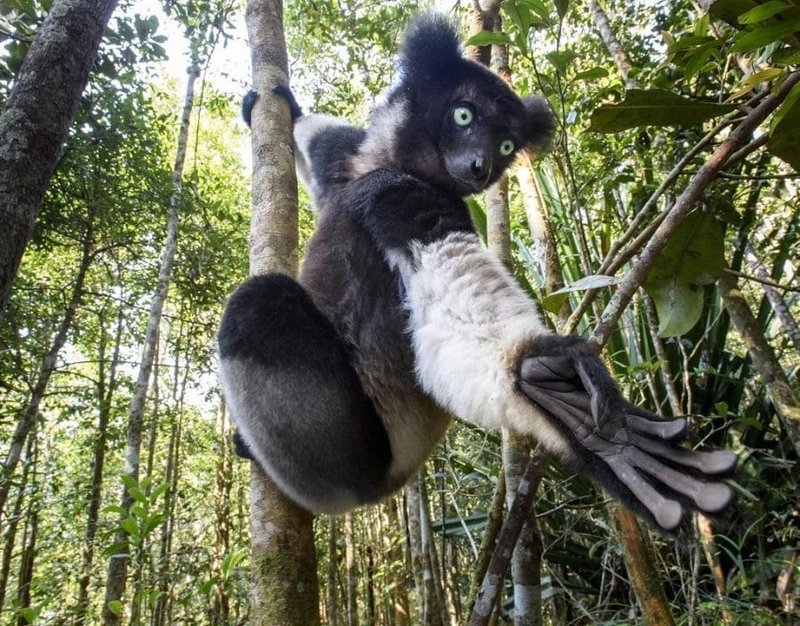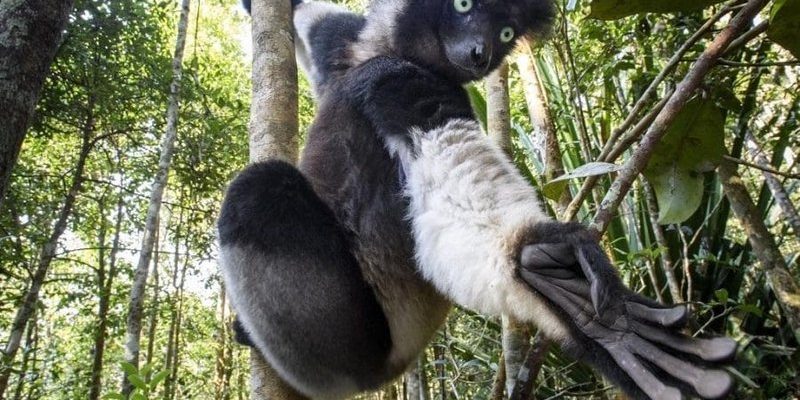
When it comes to their diet, Indris are picky eaters, but that’s what makes them interesting. They have specific preferences that shape their daily lives, and their hunting strategies are a combination of social structure and environmental awareness. Understanding how these animals find food can help us appreciate their role in the ecosystem. So, let’s break down their diet and hunting strategies and discover what makes the Indri so special.
The Indri’s Unique Diet
The Indri’s diet primarily consists of leaves, fruits, flowers, and seeds. They’re known as folivores, which means they mainly eat leaves. In fact, about 90% of their diet is made up of leaves! But not just any leaves will do. Indris are selective about the plants they munch on. They prefer tender, young leaves from specific trees like the *Ficus* and *Erythrina*.
But why leaves, you might wonder? Well, leaves are rich in essential nutrients, even if they have lower energy content. This means that Indris need to eat a large quantity of leaves to get the energy they need to thrive. Just think of it as a big salad—plenty of greens, but not always that filling!
In addition to leaves, these lemurs will also snack on fruits and flowers, especially during the fruiting season. When fruits ripen, you might catch them enjoying a juicy feast. This diverse diet is essential because it helps them adapt to seasonal changes. It ensures they’re not only satisfied but also maintaining their health in varying conditions.
Feeding Habits of the Indri
Indris have some interesting feeding habits that reflect their unique lifestyle. For one, they are diurnal, meaning they’re active during the day. This helps them take advantage of the sunlight while searching for their favorite foods. They typically feed in small groups, which allows them to share knowledge about the best feeding spots.
During feeding sessions, you might see a group of Indris spreading out on different branches, each nibbling on their leafy snacks. This social behavior not only strengthens their bond but also increases their chances of spotting predators. Plus, with their keen sense of smell and strong vocalizations, they communicate with each other about food and safety.
Becoming agile eaters is also part of their charm. Indris can leap between trees, twisting their bodies mid-air to reach their preferred food sources. You could say they perform a ballet in the treetops. It’s a mesmerizing sight, showcasing how their diet has influenced their physical adaptations.
Hunting Strategies of the Indri
Now, you might be thinking, “Aren’t Indris just leaf-eaters?” While it’s true that they focus on leaves, they use hunting strategies in how they find food. The word “hunting” might sound a bit dramatic in this context, but it perfectly captures their method of foraging.
Indris employ a technique known as “pursuit foraging.” This means they actively search for food by moving through their habitat while keeping an eye out for the best foliage. They don’t just plop down anywhere; they assess their environment. It’s like being on a treasure hunt, where they’re looking for the ideal leafy snack!
Another strategy involves foraging in specific locations at different times of the year. For example, they might return to a favorite tree at a certain time, knowing that the leaves will be at their peak tastiness. This is a learned behavior—an impressive testament to their ability to adapt and thrive in their environment.
The Role of Social Structure in Hunting
Indris live in family groups, which plays a crucial role in their feeding strategies. Typically, a group consists of a mating pair and their offspring. The social structure helps them find food more efficiently and keep each other safe from predators. You might even think of them as a support network, looking out for one another.
When they’re out searching for food, an adult Indri might take the lead, showing the younger ones where to find the best offerings. It’s almost like passing down family secrets! As they learn from each other, younger Indris become skilled foragers, which is essential for their survival.
Family bonds also come into play during those social feeding sessions. The indris communicate through loud, distinctive calls that alert others about food sources or any potential dangers hovering nearby. This vocalization is not just lovely music; it’s part of their successful hunting strategies.
Seasonal Changes and Their Impact
As the seasons change, so does the Indri’s hunting and feeding behavior. During the wet season, when food is plentiful, they can afford to be choosy, while in the dry season, they need to stretch their resources. Changes in temperature and rainfall influence the availability of leaves and fruits, which directly impacts their diet.
During the dry months, Indris might spend more time foraging and exploring new feeding areas. It’s like adapting to survive a changing buffet! They have to be quite clever and aware of their surroundings to thrive. In these moments, they rely heavily on their learned behaviors passed down from their parents.
This adaptability showcases their resilience and helps ensure their survival in varying climates. It’s a reminder of how interconnected nature is, and how vital it is for species to be flexible and resourceful.
Threats to the Indri’s Diet and Hunting
Unfortunately, the Indri faces several threats that impact its diet and hunting strategies. Habitat loss due to deforestation is one of the most significant challenges. As trees are cut down for logging and agriculture, the Indri’s food sources dwindle. Fewer trees mean less access to their preferred leaves and fruits.
Additionally, the increasing human population in Madagascar leads to more encroachment into Indri territories. This reduces the space they have for foraging, making it even harder for them to find food.
Conservation efforts are crucial to protect these unique animals and their habitats. Organizations work hard to raise awareness about the importance of preserving the forests that Indris call home. It’s a tough battle, but it highlights the need to think about how our actions can affect these incredible creatures.
Understanding the diet and hunting strategies of the Indri gives us a glimpse into their fascinating world. From their leaf-loving palate to their social foraging techniques, these lemurs are a vital part of Madagascar’s ecosystem. Their unique adaptations and intelligent social structures remind us of the delicate balance of nature.
As we continue to learn more about these amazing animals, let’s also consider how we can help protect their environment. After all, the Indri’s survival is a shared responsibility. Embracing their legacy is crucial to ensuring future generations can enjoy the beauty and wonder of these remarkable creatures.

